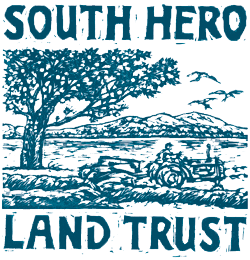Trees of South Hero
A Geocaching Adventure!
A Joint Project of the South Hero Historical Society, the Worthen Library, and South Hero Land Trust
OUR GEOCACHES ARE MIGRATING BACK TO SOUTH HERO
STAY TUNED TO OUR SOCIAL MEDIA FOR UPDATES ON THEIR 2024 ARRIVAL!
Scattered across South Hero is a series of secret geocaches, and it’s up to YOU to find them! Each geocache is made up of a small box hidden near a particular kind of native tree.
Two ways to get started…
Old school: Use the clues, the map and GPS coordinates provided below to locate the geocache for each tree. Download the map and info guide as a PDF HERE >>
OR...
New school: Visit www.geocaching.com to learn how geocaching works, then download the app on your phone, or use the website, and search for “Trees Of South Hero” to get started!
Then...
- Find Geocaches: Once you find one, you can log your find in the journal and take a free sticker!
- Learn More: Scroll down for fun facts and tree clues below!
- Win Prizes: Collect all 4 stickers and you can win a prize! Bring your stickers to the Worthen Library to claim.
Please
- Stay on trails, be kind to wildlife and plants, and have fun!
On Your Mark…Get Set…GO!
FAQ
Are the Geocaches out yet?
We have not yet put out the geocaches in 2024. Stay tuned to our social media for updates on when they become active.
What are GPS Coordinates? And how do I use them?
GPS coordinates usually consist of two numbers, a latitude, and a longitude. Latitude tells you how far north or south something is, and longitude tells you how far something is west to east. Put the two numbers together will give you an exact location for any place on earth. Hint: Go to googlemaps.com and type the GPS coordinates provided into the search bar.
Do I have to use the geocaching.com app? - Not if you don’t want to! While the geocaching app can be really fun, you can do this Using the clues, map, and gps coordinates you have all the information you need. If you enjoy this experience and want to connect with others who geocache, or hunt for more geocaches around the area, then by all means check it out!
Tree Clues and Fun Facts!
Geocache #1: White Ash
There are three types of ash trees native to Vermont: Green, white and black. White ash is found in moderately dry uplands, green ash is found in moderately wet forests, and black ash is found almost exclusively in the wettest places.
Black ash trees are sacred to the Abenaki people, who call it ‘Mahlakws’. According to legend, the Abenaki people were born from the black ash tree. The Abenaki also use the black ash for basketry, pounding the inner bark, separating it from the trunk, and cutting it into strips that are woven together, often dyed into different colors using plant-based dyes such as butternuts.
Ash trees have very strong, dense wood, and so they are also used for many different things, including baseball bats, hockey sticks, and more.
Watch contemporary Abenaki ash-basketry in this video!
Ash in Trouble
Ash trees are at risk from the deadly and invasive emerald ash borer, an insect that is devastating ash trees across the US, but there is a lot we can all do to help save these trees. The most important thing we can do is “Slow the Spread'' of the ash borer, to give our ash trees as much time as possible to come up with natural adaptations. Trees are pretty amazing at fighting off pests, through chemicals in their bark, attraction of predatory spiders and other insects that eat pests, and more. We just need to give them the time they need to come up with those defenses.
The Vermont Dept. of Fish & Wildlife recommends people NOT move firewood from town to town, which is the main way that ash borers spread to new areas.
We can also LEAVE ASH TREES wherever possible. Only about one in a hundred ash trees alive today is expected to survive to maturity, due to the emerald ash borer. The more ash trees we leave alive, the more chance the species has of avoiding extinction. Ash trees should ONLY be cut down when they are at risk of falling on a house, a road, or other important infrastructure.
Learn more about emerald ash borer and what you can do to help at https://vtinvasives.org/
How to ID an ash
You can identify ashes by looking for trees with opposite branching (not many trees do this) and compound leaves formed by clusters of leaflets. Ashes also tend to have “diamond” shaped lines in the bark. [photo of bark photo]




